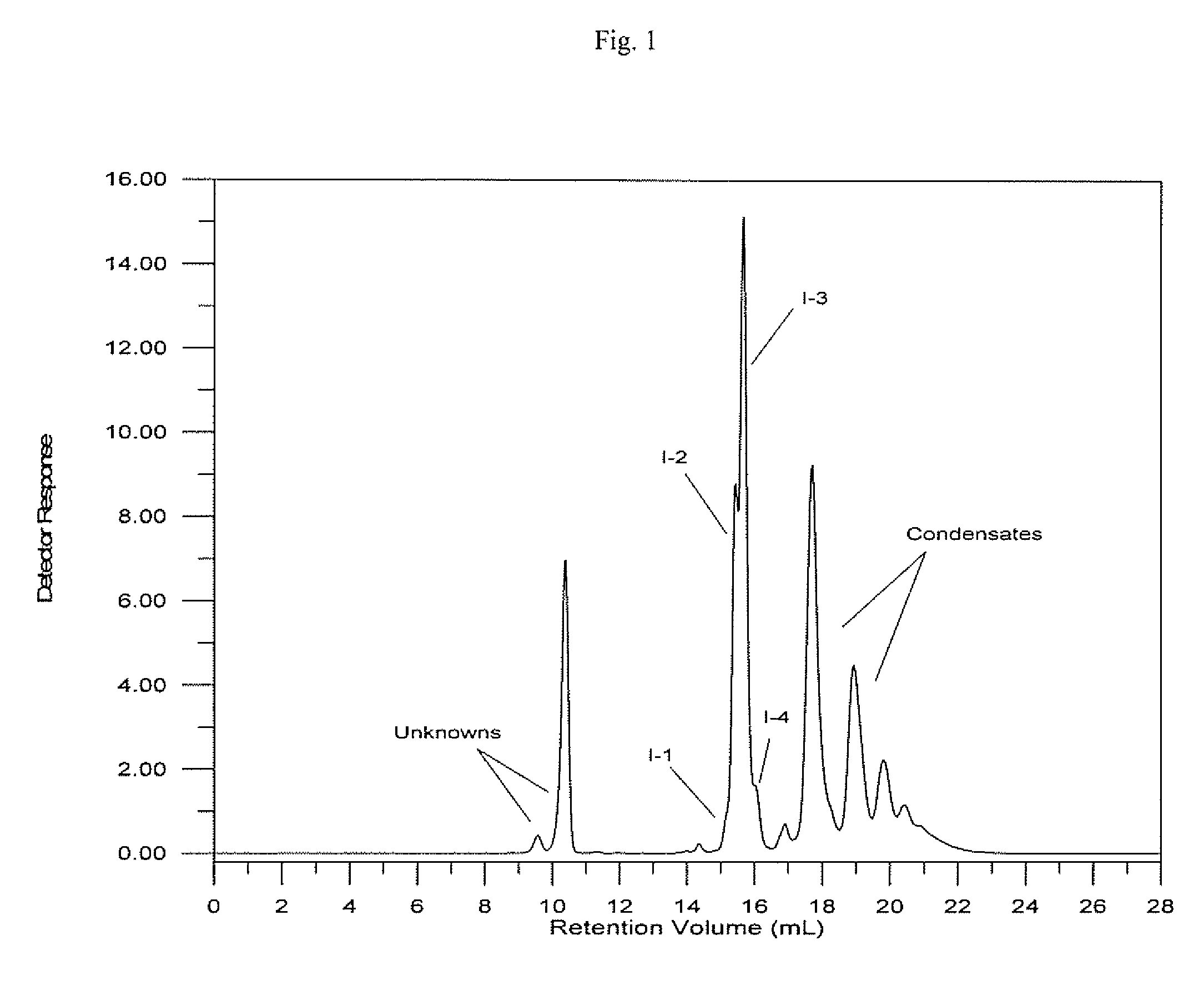Tire compositions and components containing free-flowing filler compositions
a filler composition and composition technology, applied in the field of filler compositions, can solve the problems of increasing the composition of rubber, making processing more difficult, and the composition of rubber is still more difficult to process than the composition of rubber filled conventionally with carbon black, and achieves excellent dispersion of filler, improve rolling resistance, and improve the effect of wear characteristics
- Summary
- Abstract
- Description
- Claims
- Application Information
AI Technical Summary
Benefits of technology
Problems solved by technology
Method used
Image
Examples
example 1
Preparation of (6-triethoxysilyl-3-thia-1-hexyl)-bis -(7-triethoxysilyl-3,4-dithiaheptyl)cyclohexane, related oliogmers and bis-(3-triethoxysilylpropyl)polysulfide mixture
[0146]This example illustrates the preparation of a silated cyclic core disulfide from a core containing three vinyl groups through the formation of an intermediate thioacetate silane. The tris-(4-oxo-3-thiapentyl)cyclohexane was prepared by the reaction of thioacetic acid with trivinylcyclohexane. Into a 5 L, three-neck round bottomed flask equipped with magnetic stir bar, temperature probe / controller, heating mantle, addition funnel, condenser, and air inlet were charged 1,2,4-trivinylcyclohexane (779 grams, 4.8 moles) and t-butyl peroxide (8.0 grams, 0.055 mole). Freshly distilled thioacetic acid (1297 grams, 16.8 moles) was added by means of an addition funnel over a period of 30 minutes. The temperature rose from room temperature to 59° C. The reaction mixture was allowed to cool to room temperature, tert-buty...
example 2
Preparation of (6-triethoxysilyl-3-thia-1-hexyl)-bis-(9-triethoxysilyl-3,4,5,6-tetrathianonyl)cyclohexane, related oliogmers and bis-(3-triethoxysilylpropyl)polysulfide mixture
[0152]The dimercaptan silane intermediate, (6-triethoxysilyl-3-thia-1-hexyl)-bis-(2-mercaptoethyl)cyclohexane, was prepared by the procedure described in Example 1.
[0153]The product, (6-triethoxysilyl-3-thia-1-hexyl)-bis-(9-triethoxysilyl-3,4,5,6-tetrathianonyl)cyclohexane, related oliogmers and bis-(3-triethoxysilylpropyl)polysulfide mixture, was prepared by reacting the dimercaptan silane with base, sulfur and 3-chloropropyltriethoxysilane. Into a 2 L, three-neck round bottomed flask equipped with magnetic stir bar, temperature probe / controller, heating mantle, addition funnel, distilling head and condenser, and nitrogen inlet were charged bis-(2-mercaptoethyl)(6-triethylsilyl -3-thia-1-hexyl)cyclohexane (249.7 grams 0.53 mole), sodium ethoxide in ethanol (345.2 grains of 21% sodium ethoxide, purchased from ...
example 6
[0167]Zeosil 1165 MP silica from Rhone-Poulenc of Lyon, France (50 grams) with the following properties:
[0168]
CharacteristicValueBET surface area180 m2 / gCTAB surface area160 m2 / gDOP adsorption270 ml / 100 gramsWater loss at 105° C. 6%Loss on ignition at 1000° C.10.5%SiO298.5%Al2O3 0.4%pH6.5
is poured into a 1 liter wide-mouthed jar. The open jar is placed in a ventilated oven at 105° C. and left for drying for 4 hours. The infrared absorption differential is 1.12. To the hot silica, the silated cyclic core polysulfide from Example 2 (50 grains) is added in one portion and the jar is closed and shaken manually for 30 seconds. The resulting compound is a dry, free-flowing solid that does not stick to the container walls.
[0169]The extraction test is performed in a 100 ml Soxhlet extraction apparatus equipped with a 250 round bottom flask. The silated core polysulfide and silica mixture (30 grams) is placed in a paper cartridge and acetone of dry analytical grade is placed in the flask. T...
PUM
| Property | Measurement | Unit |
|---|---|---|
| glass-transition temperature Tg | aaaaa | aaaaa |
| glass-transition temperature Tg | aaaaa | aaaaa |
| weight percent | aaaaa | aaaaa |
Abstract
Description
Claims
Application Information
 Login to View More
Login to View More - R&D
- Intellectual Property
- Life Sciences
- Materials
- Tech Scout
- Unparalleled Data Quality
- Higher Quality Content
- 60% Fewer Hallucinations
Browse by: Latest US Patents, China's latest patents, Technical Efficacy Thesaurus, Application Domain, Technology Topic, Popular Technical Reports.
© 2025 PatSnap. All rights reserved.Legal|Privacy policy|Modern Slavery Act Transparency Statement|Sitemap|About US| Contact US: help@patsnap.com



